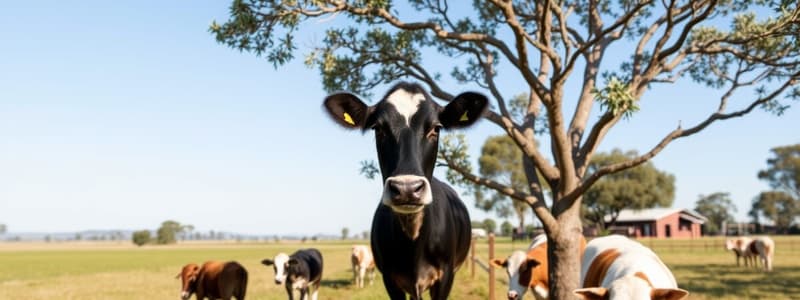Podcast
Questions and Answers
What is the primary purpose of observing best practice cattle handling techniques?
What is the primary purpose of observing best practice cattle handling techniques?
- To improve environmental conditions
- To enhance cattle breeding techniques
- To increase cattle production
- To ensure safety during handling (correct)
Which technique is essential for working cattle through yards?
Which technique is essential for working cattle through yards?
- Point of balance (correct)
- Waiting for cattle to comply
- Aggressive handling
- Fluid movement
What should be included in a risk assessment for handling cattle?
What should be included in a risk assessment for handling cattle?
- All the potential hazards associated with handling (correct)
- Health status of cattle
- Available feed supplies
- Weather conditions
What feature contributes to good yard design for handling cattle?
What feature contributes to good yard design for handling cattle?
Which method helps minimize stress for cattle during handling?
Which method helps minimize stress for cattle during handling?
What is a common misconception about flight zones in cattle handling?
What is a common misconception about flight zones in cattle handling?
What is a key aspect of safe cattle handling that should be practiced?
What is a key aspect of safe cattle handling that should be practiced?
What is the purpose of estimating breeding values (EBVs)?
What is the purpose of estimating breeding values (EBVs)?
Why is it important to engage in risk assessment before handling cattle?
Why is it important to engage in risk assessment before handling cattle?
Which production traits are typically recorded as EBVs?
Which production traits are typically recorded as EBVs?
What is a seedstock operation?
What is a seedstock operation?
In the context of cattle weight gain studies, what should be calculated if more than one animal is used per treatment group?
In the context of cattle weight gain studies, what should be calculated if more than one animal is used per treatment group?
Why are stacked line graphs useful in analyzing weight gain over time?
Why are stacked line graphs useful in analyzing weight gain over time?
What could a researcher conclude if one diet resulted in significantly higher weight gain than others?
What could a researcher conclude if one diet resulted in significantly higher weight gain than others?
Which of the following is NOT typically a component of the BREEDPLAN database?
Which of the following is NOT typically a component of the BREEDPLAN database?
What was a key consideration in assessing the results of a weight gain study?
What was a key consideration in assessing the results of a weight gain study?
What type of data can NLIS tags be used to track aside from production data?
What type of data can NLIS tags be used to track aside from production data?
What is a primary benefit of using a calendar of operations on a beef property?
What is a primary benefit of using a calendar of operations on a beef property?
Which aspect of data management is NOT mentioned in relation to NLIS?
Which aspect of data management is NOT mentioned in relation to NLIS?
What type of data would likely be included in the breeding history tracked by NLIS tags?
What type of data would likely be included in the breeding history tracked by NLIS tags?
How does the calendar of operations assist farm managers?
How does the calendar of operations assist farm managers?
What was the primary hypothesis behind selecting for slower growth rates in certain cattle breeds?
What was the primary hypothesis behind selecting for slower growth rates in certain cattle breeds?
Which group of Angus cattle had the fastest growth rates in the experiment?
Which group of Angus cattle had the fastest growth rates in the experiment?
What are some of the types of livestock that seedstock operators sell?
What are some of the types of livestock that seedstock operators sell?
When was the experiment that led to the development of Lowlines conducted?
When was the experiment that led to the development of Lowlines conducted?
What was the primary focus of the study conducted by the NSW Department of Agriculture?
What was the primary focus of the study conducted by the NSW Department of Agriculture?
Where were the herds for the Angus cattle experiment set up?
Where were the herds for the Angus cattle experiment set up?
Which of the following statements about Lowlines is true?
Which of the following statements about Lowlines is true?
What is one potential benefit of selecting for smaller breeding cows?
What is one potential benefit of selecting for smaller breeding cows?
What is the primary reason for introducing Brahman cattle to Alexandria Station?
What is the primary reason for introducing Brahman cattle to Alexandria Station?
What is the size of Alexandria Station in hectares?
What is the size of Alexandria Station in hectares?
What type of cattle did Alexandria Station originally run?
What type of cattle did Alexandria Station originally run?
What is a primary feature of Alexandria composite cattle?
What is a primary feature of Alexandria composite cattle?
Which of the following roles do staff at Alexandria Station perform?
Which of the following roles do staff at Alexandria Station perform?
What particular issue contributed to the decline of Shorthorn cattle at Alexandria Station?
What particular issue contributed to the decline of Shorthorn cattle at Alexandria Station?
What is one of the primary products of Alexandria Station?
What is one of the primary products of Alexandria Station?
How many staff members are employed at Alexandria Station?
How many staff members are employed at Alexandria Station?
Flashcards are hidden until you start studying
Study Notes
Alexandria Station Overview
- Alexandria Station, situated on the Barkly Tableland in Northern Territory, spans over 1.6 million hectares, making it Australia's second-largest farm.
- Approximately 70,000 cattle are raised on the station.
- Owned by the Northern Australian Pastoral Company.
Cattle Breeds and Management
- Originally used Shorthorn cattle, which were selected for longevity and ability to travel long distances.
- Shorthorns struggled in northern climates due to:
- High calf loss rates.
- Cattle tick infestations.
- Brahman cattle were introduced as they are more resilient to harsh Australian conditions.
- Composite cattle, a hybrid of Shorthorns and Brahmans, are produced for chilled beef markets, both domestically and internationally.
Operational Aspects
- The station operates two outposts and employs over 50 staff for various roles, including:
- Stock handling.
- Catering.
- Transportation (road trains and aircraft).
- Water supply monitoring and administrative tasks.
Cattle Handling Practices
- Emphasis on best practice techniques for safe cattle handling.
- Importance of communication and risk assessment in handling.
- Key techniques include:
- Utilizing flight zones.
- Understanding point of balance.
- Implementing parallel movement to direct cattle.
Risk Assessment
- Conduct assessments for cattle handling using detailed templates to ensure safety during activities.
- Develop stacked line graphs to analyze weight gain over various diets and interpret results effectively.
Beef Seedstock and Breeding
- Seedstock refers to registered breeding cattle used for genetic improvement in beef cattle.
- Estimated Breeding Values (EBVs) are used for evaluation, which includes traits like weight gain and fertility.
- BREEDPLAN is the Australian database tracking these traits across different beef breeds.
- Semen from high EBV bulls can be selected by commercial producers for breeding programs.
Lowline Cattle Initiative
- Originated from a 1974 experiment aimed at investigating slow growth rates in Angus cattle, leading to the establishment of Lowlines as a recognized breed.
- The hypothesis focused on potential benefits of slower growth leading to smaller, more feed-efficient breeding cows.
- Three groups evaluated effects on carcass traits, productivity, and fertility:
- Lowlines (slower growth).
- Highlines (faster growth).
- Control group (random selection).
Data Management in Cattle Production
- National Livestock Identification System (NLIS) tags maintain records of production, reproduction, and health data.
- Essential for tracking cattle info like weight gain and vaccination history.
- A calendar of operations aids in planning yearly activities on beef properties, including input purchases and labor needs.
Studying That Suits You
Use AI to generate personalized quizzes and flashcards to suit your learning preferences.




